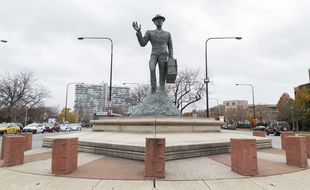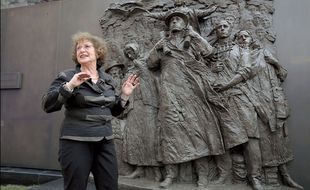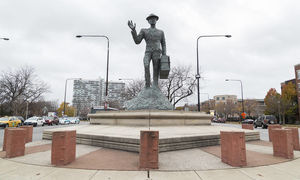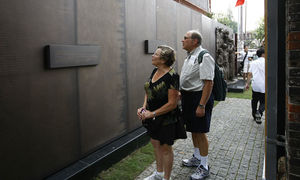Story of the Sculpture
Introduction
Although many migration memorials are in the form of plaques, some artists create the monuments as character statues of individuals. Those individuals are not real people existing in the history but figures or images the sculptors come up with. They have unique traits and prominent features implicating their own experience. In this way, the sculpture of single person represents the whole community of an ethnic group and all immigrants as every scar and every wound on the sculptures shows the difficulties and obstacles the whole community have experienced. In this article, I will show how the structures, characteristics, and configurations of the statues state the ideas sculptors want to express towards whole immigrant communities.
Monument to New Immigrants
Tania Bruguera’s Monument to New Immigrants served as a meditation on the history and significance of immigration in Philadelphia and beyond. The idea behind the statue is not to represent a particular person, but all the immigrants; for this reason, it doesn’t have any specific gender or appearance, and it does not have a “face.” The lack of facial details is a way to emphasize the sense of unsettlement that immigrants experience: they are not always in one place; part of them is somewhere else, in their home country, and their identity is formed by their experiences in their new place. The sculpture will be clay, and it will be very detailed; however, it will be exposed to rain, wind, and sun in order to deteriorate and slowly disappear. This performative aspect of the sculpture explains the endless condition of immigration: when a community is accepted, there is always a new one asking for hospitality. The statue represents a kid as a metaphor for what is experienced once you immigrate: no matter how old a person is, they need to start over.
Monument to Great Northern Migration
This fifteen-foot tall, north-facing bronze figure by Alison Saar depicts a man waving with one hand and carrying a suitcase. It represents the six million African Americans who migrated to northern cities from the Southern part of United States from the 1910s to the 1970s. The figure is crafted as a man standing on the mound of thousands of worn soles, which fully cover his clothes as well. This design implicates the obstacles African American have experienced and overcome on the journey to the north. In traveler’s hand, he carries a worn suitcase symbolic of his journey, dreams and talents. His other hand is raised and waves towards his new home and he is oriented to the north signals the destination. Those features all indicate the willingness of immigrants to move to and settle in the northern cities and their expectations towards new lands.
Jewish Refugee Memorial Wall
Jewish Refugee Memorial Wall is part of Shanghai Jewish Refugee Museum. The wall mainly portrays 6 Jewish refugees, but it lists the names of all 13,732 Jewish refugees who settled in Shanghai during World War II. The depictions of an orthodox Jew, an elderly Jewish woman, a middle-aged man, a child and a young man and woman represent faith, suffering and love, determination for the future, and brightness and hope, according to Chinese artist He Ning, who designed them. They represent the tenaciousness of all Jewish refugees who fled to Shanghai, their new home.
Work Cited
Monument to New Immigrants, Monument Lab, 2017, https://monumentlab.com/monument-to-new-immigrants
Alison Saar's Monument to the Great Northern Migration, City of Chicago, https://www.chicago.gov/city/en/depts/dca/supp_info/chicago_s_publicart-alisonsaarsmonumenttothegreatnorthernmigrati.html
Wang Hingyi, Memorial Wall Honors Jewish Refugees, China Daily, 3 September 2014, http://www.chinadaily.com.cn/china/2014-09/03/content_18537562.htm

efa4.jpg?itok=IidL1JBD)


5a2a.jpg?itok=PrnaOHTr)

